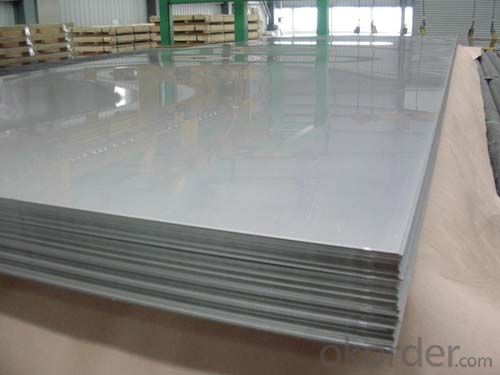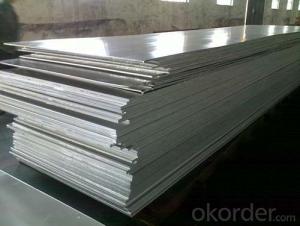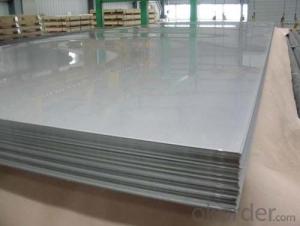5052 Aluminum Plate And Alloy Aluminum Sheets
- Loading Port:
- China main port
- Payment Terms:
- TT OR LC
- Min Order Qty:
- 5 m.t.
- Supply Capability:
- 5000 m.t./month
OKorder Service Pledge
OKorder Financial Service
You Might Also Like
Item specifice
1.Specifications of 5052 Aluminum Plate And Alloy Aluminum Sheets
Product | aluminum plates 5052 |
Material | 5052 |
Temper | H24 |
Dimension | 4.0mm*1500mm*3000mm |
Alloy or not | is-alloy |
Surface | mill finish |
Property | anti-corrosion,heat resistant,good plasticity |
Technical Standard | GB/T 3880-2006,JIS,ASTM-B209,EN480 |
Tensile strength | 120~145 MPa |
Elongation | ≥6% |
Application | storage device,decoration,pressure essels,construction,electrical equipment,etc |
2. Application of 5052 Aluminum Plate And Alloy Aluminum Sheets
(1).Interior: wall cladding, ceilings, bathrooms, kitchens and balconies, shutters, doors...
(2).Exterior: wall cladding, facades, roofing, canopies, tunnels,column covers , renovations...
(3).Advertisement: display platforms, signboards, fascia, shop fronts...
3. Feature of 5052 Aluminum Plate And Alloy Aluminum Sheets
*Such coil is specially designed to replace aluminum ingot, due to the high export tax of aluminum ingot, the coil has better price than ingot.
*This type of coil can fit customer's remelting furnace just like ingot, no need to make any change to the production line that was previously used for ingot. The standard coil size and weight is very suitable for the feed gate of furnace.
*This type of coil causes less material wastage than ingot when remelted.
*Our coil is made directly from ore, no need to go though the ingot making process, quality is much better than other suppliers who use ingot scrap to make coil.
Be free from Oil Stain, Dent, Inclusion, Scratches, Stain, Oxide Dicoloration, Breaks, Corrosion, Roll Marks, Dirt Streaks and other defect which will interfere with use
4. Certificate:
SGS and ROHS(if client request, paid by client), MTC(plant provided), Certificate of Origin(FORM A, FORM E, CO), Bureau Veritas and SGS (if client request, paid by client), CIQS certificate
5. Image of 5052 Aluminum Plate And Alloy Aluminum Sheets


6. FAQ
1) What is your delivery time?
Our regular production time is over 30 days, It depends on the order quantity also.
2) What is your payment term?
We accept T/T, LC at sight, Usance LC 30, 60, 90, 120, 180 DAYS.
3) What is your price structure?
Our foil price is based on Shanghai Metal Price(SMM), not LME, but we could offer LME+ Conversion for your reference.
4) What is your Delivery term?
We do FOB, CFR, CIF, we don't do DDP.
5) Could you offer sample?
We could offer sample as your requirement. A4 Size sample is free for you, for bigger roll sample, it depends on the coil weight.
- Q:How does the surface roughness affect the adhesion of coatings on aluminum sheet?
- Surface roughness plays a crucial role in the adhesion of coatings on aluminum sheet. The level of roughness on the surface of the sheet directly impacts the mechanical interlocking between the coating and the substrate, which is essential for strong adhesion. When the surface of the aluminum sheet is smooth, there is limited contact area between the coating and the substrate, resulting in weak adhesion. On the other hand, a rough surface provides more contact points, increasing the interlocking between the coating and the aluminum sheet, leading to improved adhesion strength. Additionally, a rough surface promotes better wetting of the coating material on the aluminum sheet. This means that the coating material can spread more easily over the surface, filling in any gaps or crevices, and creating a more uniform and continuous coating. This improved wetting contributes to enhanced adhesion. Furthermore, a rough surface can also increase the overall surface area of the aluminum sheet. A larger surface area means that there is more available space for the coating material to adhere to, increasing the adhesion strength. It is important to note that there is an optimum level of roughness for achieving the best adhesion. If the surface is excessively rough, it may lead to incomplete coverage of the coating material or the formation of voids, reducing adhesion. Therefore, finding the right balance of roughness is crucial to ensure optimal adhesion of coatings on aluminum sheet.
- Q:Are aluminum sheets suitable for signage?
- Yes, aluminum sheets are suitable for signage. They are lightweight, durable, and weather-resistant, making them a popular choice for outdoor and indoor signage applications. Additionally, aluminum sheets can be easily customized, printed, and mounted, allowing for versatile and long-lasting signage solutions.
- Q:What are the different forming techniques for aluminum sheets?
- Aluminum sheets can be shaped using several different forming techniques. One technique commonly used is bending, where force is applied to the sheet to achieve the desired shape. This can be done manually with a press brake or through automated processes like roll forming or stretch forming. Another technique, called deep drawing, involves using a die and punch to stretch the aluminum sheet into a three-dimensional shape. This method is often employed to create cylindrical or box-shaped components such as cans or containers. Hydroforming is another option for shaping aluminum sheets. It utilizes hydraulic pressure to mold the sheet against a form or mold. This technique is particularly useful for creating complex and irregular shapes that would be challenging to achieve with other methods. For creating symmetrical shapes like bowls or cones, spinning is a commonly used technique. It entails rotating the aluminum sheet against a mandrel while applying pressure to shape it into the desired form. Lastly, there is a technique known as stamping, which involves pressing the aluminum sheet against a die to create a specific shape. This technique is frequently employed in high-volume production of components such as automotive body panels. In conclusion, these forming techniques provide a wide range of options for shaping aluminum sheets into various forms and designs. This allows for flexibility and versatility in manufacturing processes.
- Q:What is the surface finish of 101 aluminum sheets?
- The surface finish of 101 aluminum sheets can differ based on the specific manufacturing process and desired application. However, typical surface finishes for these sheets include mill finish, brushed finish, anodized finish, and painted finish. The mill finish refers to the untreated surface of the aluminum sheet, which may have some small imperfections or scratches. To achieve a brushed finish, the surface of the sheet is brushed with a fine abrasive material, resulting in a smooth and satin-like appearance. Anodized finish involves an electrochemical process that creates a protective oxide layer on the aluminum surface, giving it enhanced durability and resistance against corrosion. On the other hand, a painted finish involves applying a layer of paint onto the aluminum sheet to give it color and additional protection. Ultimately, the choice of surface finish for 101 aluminum sheets depends on the specific aesthetic, functional, and environmental requirements of the application.
- Q:... initial temperature of the water or the initial temperature of the aluminum? Why?
- The correct equation is: dQ = m*c*dT As dQ (substitute of thermal potential) and mass are the comparable, the equation may well be rewritten as: c*dT=consistent So a cloth with a decrease specific warmth skill could have a much better improve in temperature. The question has already suggested this yet now all of us be attentive to they are inversely proportional. to that end: c of aluminium/c of copper = dT of aluminium / dT of copper 0.22/0.092 = proportionality consistent = 2.39 So copper would be 2.4 circumstances warmer than aluminium (or aluminium would be 0.40 two circumstances warmer than copper).
- Q:What is the typical cost-effectiveness of aluminum sheets compared to other materials?
- The cost-effectiveness of aluminum sheets can vary based on several factors, such as the specific application, size, thickness, and market conditions. However, aluminum sheets are generally deemed cost-effective due to their unique properties and versatility. Aluminum, being a lightweight material, requires less material to achieve the same strength as heavier alternatives. This can lead to cost savings in terms of transportation, installation, and overall project expenses. Moreover, aluminum sheets possess excellent corrosion resistance, durability, and a long lifespan, which further contribute to their cost-effectiveness over time. In addition, aluminum is highly recyclable, resulting in significant savings in terms of energy and resources during the recycling process. This recyclability enhances the overall cost-effectiveness of aluminum sheets, as they can be reused or repurposed rather than being discarded as waste. Although the initial cost of aluminum sheets may be higher compared to some other materials, the long-term benefits and savings they offer often outweigh the initial investment. When assessing the cost-effectiveness of aluminum sheets compared to other materials, it is crucial to consider factors such as durability, maintenance costs, energy efficiency, and environmental impact. Ultimately, the cost-effectiveness of aluminum sheets compared to other materials will depend on the specific requirements and circumstances of each project. It is recommended to consult industry experts or suppliers to evaluate the cost-effectiveness of aluminum sheets for a particular application in relation to other materials.
- Q:Right now I have got some problems on how to machine high purity aluminium machinery,are thery any suggestions to promote for this kind of consecutive issue?
- Aluminum okorder is a soft, silvery-white metal. In high-purity aluminum nearly all impurities have been removed. It is 99.99 percent pure and is machined like other grades of aluminum. To process aluminum for various applications, the manufacturer heats the aluminum in a smelter and then forms it into ingots (large blocks) or billets (log-shaped rods). Using rolling mills, workers machine ingots into aluminum plates, sheets or foils. Dies machine ingots or billets into extrusions or forgings.
- Q:How are aluminum sheets different from aluminum plate?
- Aluminum sheets and aluminum plates are two forms of aluminum metal that differ primarily in terms of thickness. Aluminum sheets are typically thin, flat pieces of aluminum that are less than 6mm thick. They are commonly used in applications where lightweight and flexibility are important, such as in the construction of aircrafts, automobiles, and electronic devices. On the other hand, aluminum plates are thicker and heavier than sheets, typically measuring 6mm or more in thickness. Plates are often used in applications that require strength and durability, such as in the construction of heavy machinery, structural supports, and marine equipment. While both sheets and plates are made from aluminum, their distinct thicknesses make them suitable for different purposes.
- Q:im making a presentation and once i read through it it feels like its leading up to something but then goes flat. any ideas. my project ' steel cars compared to aluminium'
- Aluminium is extremely flammable. We use it in thermite welding and as solid rocket fuel. The Emperor Napoleon carried* an aluminium fork while the lower royalty had to make do with gold forks. *In those days people carried their table wear around with them same as we carry our car keys.
- Q:Are 101 aluminum sheets available in different finishes (e.g., brushed, polished)?
- There are different finishes available for 101 aluminum sheets, including brushed and polished. These finishes are obtained using various methods that create distinct textures and appearances on the surface of the sheets. To achieve a brushed finish, the sheet is brushed with an abrasive material, resulting in a pattern of fine lines. This finish is commonly used to give the sheet a matte look. On the other hand, a polished finish is achieved by polishing the sheet to create a high shine. This finish is often chosen to create a smooth and reflective surface. Therefore, depending on the desired aesthetic or functional requirements, one can opt for either a brushed or polished finish for 101 aluminum sheets.
1. Manufacturer Overview |
|
|---|---|
| Location | |
| Year Established | |
| Annual Output Value | |
| Main Markets | |
| Company Certifications | |
2. Manufacturer Certificates |
|
|---|---|
| a) Certification Name | |
| Range | |
| Reference | |
| Validity Period | |
3. Manufacturer Capability |
|
|---|---|
| a)Trade Capacity | |
| Nearest Port | |
| Export Percentage | |
| No.of Employees in Trade Department | |
| Language Spoken: | |
| b)Factory Information | |
| Factory Size: | |
| No. of Production Lines | |
| Contract Manufacturing | |
| Product Price Range | |
Send your message to us
5052 Aluminum Plate And Alloy Aluminum Sheets
- Loading Port:
- China main port
- Payment Terms:
- TT OR LC
- Min Order Qty:
- 5 m.t.
- Supply Capability:
- 5000 m.t./month
OKorder Service Pledge
OKorder Financial Service
Similar products
New products
Hot products
Related keywords




























